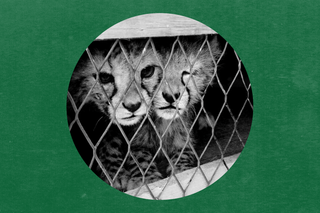
Cub Trade is Driving Cheetahs Towards Extinction
Every year an estimated 300 cheetah cubs are trafficked through Somaliland to wealthy buyers in the Middle East seeking exotic pets.

Cheetah cubs are really cute, aren’t they? Many people certainly believe so. For the cheetahs, that’s turning out to be a bane with humans loving them to death. No, literally, we’re driving the species to extinction.
Reports suggest that a century ago, there were almost 100,000 cheetahs around the world. Today, their numbers have plummeted to just about 7,000.
In India, it has been almost 70 years since cheetahs were declared locally extinct. At present, efforts are underway to introduce African cheetahs from Namibia to India after they were found to be 89% similar to their Asiatic counterpart, which we drove to extinction here. Right now, the only remaining Asiatic cheetahs are in Iran and their population size is estimated to be below 50.
Besides human encroachment and habitat destruction, trading in cheetahs as pets is believed to be responsible for the decline of this big cat species. And, of course, there’s hunting too.
The last cheetah spotted in India was hunted in Chhattisgarh in 1947. It is believed Maharajah Ramanuj Pratap Singh Deo shot and killed the last three cheetahs. Subsequently, in 1952, they were declared extinct.
Related on The Swaddle:
India’s Cheetah Reintroduction Plan Is Fraught With Political Symbolism, Short on Scientific Rigor
Besides hunting, past rulers of our country were even known to own cheetahs as pets. Reportedly, Mughal emperor Akbar is believed to have owned 9,000 cheetahs over the course of almost 50 years. Experts suggest the earliest case of domestication of a cheetah in India — for the sport of coursing, i.e., the pursuit of prey — can be traced back to the court of King Someshvara III of Kalyani in the 12th century.
“Eventually, somewhere around the early 18th century, the constant removal of cheetahs from the wild, especially cubs, reached a tipping point… And so, while their prey base and habitat survived till much later, the cheetahs were already very scarce by the time the British consolidated their hold over India and started recording the occurrence of cheetahs,” Raza Kazmi, a conservationist from Jharkhand, wrote in 2019.
Besides their cuteness, the docile nature of the animal is believed to be yet another reason for their declining numbers. “The [cheetah] is easily tamed, about six months being required to reduce him to a complete state of obedience and to complete his training. Many of these animals, when tamed, are as gentle and docile as a dog, delighting in being petted, and quite good-tempered even with strangers, purring and rubbing themselves against their friends, as cats do,” William Thomas Blanford, a naturalist from the U.K., had once explained.
A report from 2018 also found more than 900 advertisements for poached cheetahs on social media and e-commerce websites. To this day, reportedly, about 300 cheetah cubs are trafficked every year through Somaliland in the Horn of Africa to Middle Eastern buyers looking for “exotic pets.”
Related on The Swaddle:
Indians Are Trading Pangolins Illegally on YouTube
An article in the National Geographic from 2016 had actually described cheetahs as “the world’s fastest land animal and the Middle East’s hottest pet.” Laurie Marker, founder of the Cheetah Conservation Fund (CCF), told the media that a lot of exotic pet owners like showing off their cheetahs on their social media accounts. “There’s kind of a one-upmanship on it, and there’s bragging power. One of our messages is do not ‘like’ this kind of thing on social media,” Marker noted.
The cubs that survive the journey from Somaliland to the Middle East sell for around $15,000 on the black market. But only about 50% of the cubs survive. “Tiny, weeks-old cheetah cubs suckled from baby bottles and purred weakly, their condition still dangerously precarious after their rescue from the Horn of Africa’s illegal wildlife trade… Around half the cubs saved from traffickers do not survive the trauma
Lamenting on the pet trade, Marker said “if this keeps going [on]… that kind of off-take causes the population to go extinct in a very short time.”
Given that many Indians, too, love having exotic animals as pets — with 32,645 Indians, across 25 states and five union territories admitting to having live, exotic species in their possession last year — it is pertinent to ensure the African cheetahs brought into the Indian territory don’t become prey to the trade here.
Devrupa Rakshit is an Associate Editor at The Swaddle. She is a lawyer by education, a poet by accident, a painter by shaukh, and autistic by birth. You can find her on Instagram @devruparakshit.
Related


Why the Origin and Impact of the Metaverse Is Worrying
